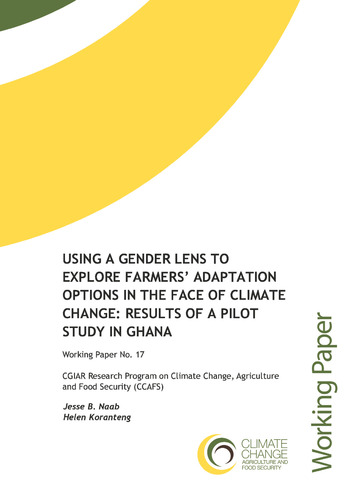Using a gender lens to explore farmers' adaptation options in the face of climate change: Results of a pilot study in Ghana
Abstract
The Upper West Region of Ghana and especially the Lawra-Jirapa districts are highly vulnerable to climate variability and likely to be amongst the worst hit under climate change. Any responses to climate change affected communities cannot be considered complete unless women-specific responses are interwoven in a variety of adaptation options considered in the target area. The overall objective of this short-term research was to test tools and methodologies developed by CCAFS, FAO on analysis of gender issues in climate change, agriculture and food security. The study took place from the 1–4 November 2011, in the village of Doggoh in the Jirapa district of the Upper West Region of Ghana.
The segment on climate analogues showed that a gender-differentiated village resource maps could be used as a tool to communicate the concept of ‘climate analogues’ and to facilitate farmer-to-farmer exchange visits to analogue sites. Both men and women groups mentioned farming practices and coping strategies as topics they would like about to learn during an exchange visit to an analogue site.
On weather information, all groups (men, women and youth) indicated they receive daily weather forecasts mainly through the radio but these are mostly received by the men and male youth because they own the radio sets. Women do not generally own radio sets in the village setting and as such, receive the daily weather information through their husbands or sons when they are in the house and switch on their radio sets. All groups (men, women and the youth) had never seen the seasonal forecast chart issued by the Ghana Meteorological Services. Both daily and seasonal weather forecasts would be preferred by the community and through the medium of the radio translated, into the local dialect. The church, the chief, assemblyman (local government representative) and agricultural extension agents could publicize the forecasts.
Currently some climate smart agricultural initiatives, like tree planting and agroforestry, exist at the individual and household level. The community expressed the desire to undertake any climate smart agricultural initiative. Several external institutions have in the past facilitated the formation of local women groups and promoted agricultural activities. These groups can be used as entry points for future climate smart agricultural initiatives. The gender-specific focus groups in this session on climate smart agriculture worked out well because no group had influence over the other, and each shared their experiences without intimidation. The guiding questions also helped in sourcing the responses from the discussants and gave order to the way questions were sequenced.

